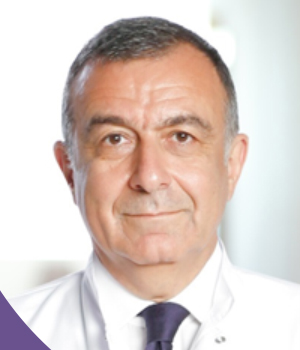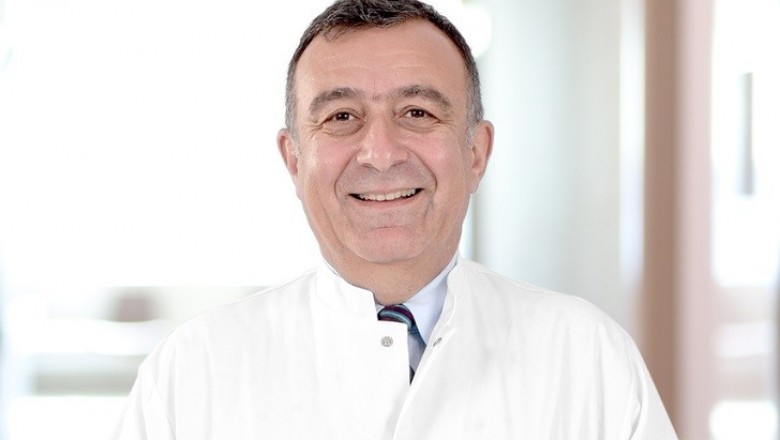Dr. Khalil Beckler
What are the different types of hand surgery?
To function normally, the hands require free and painless movement in the joints, tendons and muscles. Depending on the underlying cause of the problem, there are different types of surgeries that can be performed to achieve significant improvement in the condition of the extremities.
Operative interventions performed regularly by Prof. Dr. Khalil Beckler:
Fixation of fracture
This technique is used when there is a fracture in a part of the hand, also involving involvement of the fingers.
The type of surgery aims to fix the broken bone and then immobilize the area during the healing phase.
Operative placement can be performed using fixation with plates, screws or other means.
Interventions for tendon inflammation
Tendons are the fibres that attach muscles to bones.
Tendon injuries can occur due to infection, sudden physical injury or spontaneous rupture.
Treatment of tendonitis can be classified as primary or secondary.
- Primary recovery is within 24 hours of injury and usually requires direct surgical intervention.
- Secondary procedure - scheduled several weeks after the injury and involves tendon grafting (inserting tendons from other areas of the body), or other more complex procedures.
Operative treatment for nerve injuries of the hands
The ulnar nerve, median nerve and radial nerve are the three main nerves that innervate the arm. Damage to them can result in reduced ability to move and impaired and painful sensation.
When a nerve is severed, it can be restored surgically by directly attaching the severed parts or by using a nerve graft (inserting nerves from other areas of the body in place of the damaged nerve) to restore the damaged part.
Arthroscopy
Arthroscopy is a surgical procedure that orthopedists use to visualize, diagnose and treat problems in the joints.
Doctors use the method - arthroscopy to help diagnose and treat various joint conditions, most commonly affecting:
- Shoulder: tendon ruptures, luxations
- Knee: meniscal (cartilage) tears, chondromalacia (wear or injury to the cartilage cushion) and anterior cruciate ligament tears
- Wrist: carpal tunnel syndrome
- Loose bony and/or cartilaginous structures: e.g. knee, shoulder, elbow, ankle or wrist
- Loose bone fragments
- Inflammation of the joints
By attaching an optical video camera to the arthroscope, the surgeon can view the inside of the joint through a very small incision. The information is transmitted to a high-definition video monitor. This allows the cartilage, ligaments and knee cap to be examined. Through arthroscopy, a definitive diagnosis is made, which is more correct than X-ray examinations. The size and type of injury is also determined with accuracy.
Surgeons can operate on certain types of joint damage during the arthroscopy itself using fine surgical instruments inserted through additional minimal incisions.
Arthroscopy is suitable for all patients with orthopaedic problems, and is generally gentler and more gentle than "open" surgery. It is a particularly preferred method, especially when treating athletes, due to the frequency of injuries.
Arthroscopic surgery is performed as an outpatient procedure and patients return home just a few hours after surgery.
The usual return to daily activities is within a few days. Competitors who are in good physical condition can resume their sporting activities, even after a few weeks.
The combination with a specific activity and rehabilitation program accelerates recovery, renews and protects joint function.
Reconstruction of joints
Joint reconstruction surgery aims to significantly reduce or eliminate pain while restoring function to the affected joint.
Reconstructive surgery is successfully applied to the following conditions and diseases:
- developmental defects of the hip and knee
- in case of necessary elbow or shoulder replacement
- hip arthroplasty, as well as surgical intervention on the front of the hip joint
- knee and hip osteotomy - removal of a portion of bone near a damaged joint caused by osteoarthritis
- knee arthroplasty - minimally invasive knee surgery.
Arthroplasty
Arthroplasty is a surgical procedure performed by an orthopedic surgeon that alters or completely replaces a joint in the body.
It is usually prescribed to restore normal movement and relieve pain in a deformed or injured hip, knee, shoulder, elbow or ankle joint. Arthroplasty may also be necessary due to cartilage wear, joint space narrowing, joint stiffness, or other degenerative or traumatic conditions.
Depending on the severity of the joint problem, replacement can be performed by:
- resection arthroplasty
- interposition arthroplasty
- hemiarthroplasty
- total joint arthroplasty.
In resection arthroplasty, the orthopedic surgeon removes a minimal amount of tissue to restore function to the joint.
Hemiarthroplasty is performed to treat a problem with only one half of the joint.
Total joint arthroplasty is a surgical procedure that replaces the joint entirely. It is usually necessary after a failed conservative course of therapy.
The orthopedic surgeon uses special tools to remove the damaged parts and replaces them with a prosthesis made of artificial components, which can be manufactured from various materials with high biocompatibility - metal, plastic, silicone rubber. The artificial joint components are fixed into the healthy part of the bone and held in place by bone cement.
The implants used have varying degrees of success in their clinical use and need to be selected according to the patient's individual characteristics. The method of fixation used is also specific and is determined by the patient's age, bone condition and level of physical activity.
After arthroplasty, patients observe a period of rest and rehabilitation. Gradually, the strength and flexibility of the replaced joint is restored and normal daily life is resumed.
Prof. Dr. Khalil Bekler - Orthopaedic and Trauma Surgery
Orthopaedic and trauma surgery refers to the surgical treatment of deformities (orthopaedics) and accidents (traumatology) of the musculoskeletal system - the skeleton, muscles, tendons and ligaments.
The patient should be referred in the case of severely debilitating joint pain, restricted movement, injury at risk of aggravation and spontaneous fracture, also painful bone deformity.
Surgeons prescribe a thorough pre-operative evaluation to determine the appropriate surgical method and the use of a specific specialized technique.
The availability of modern innovations nowadays to apply in minimally invasive surgery allows specialists to noticeably reduce:
- Incision size (minimally invasive surgery)
- Risks associated with surgery (pain, infection, etc.)
- Length of patient stay in hospital etc.
- The recovery period









